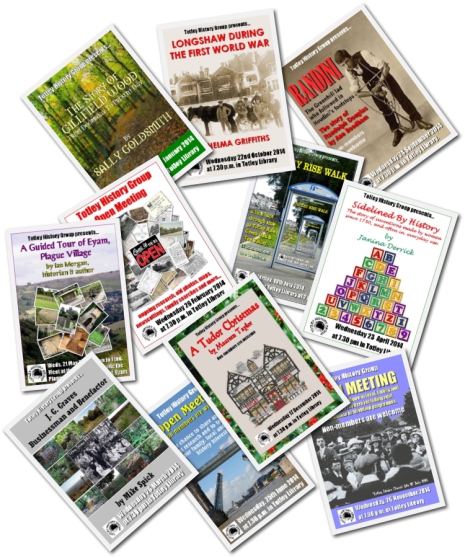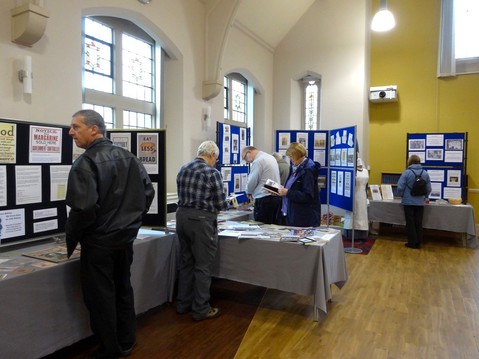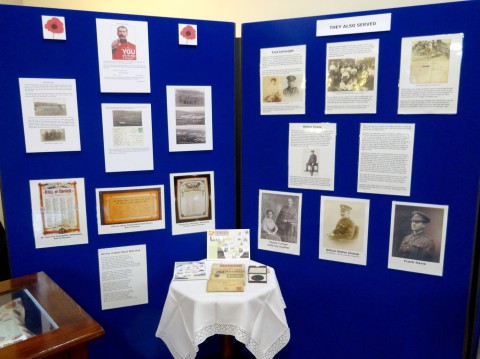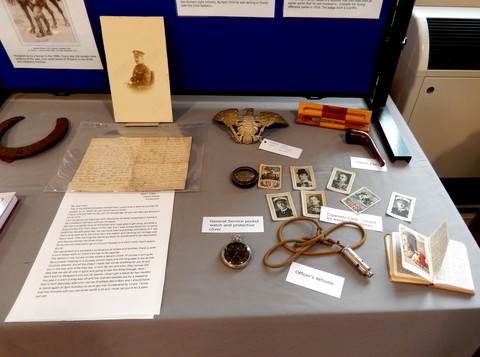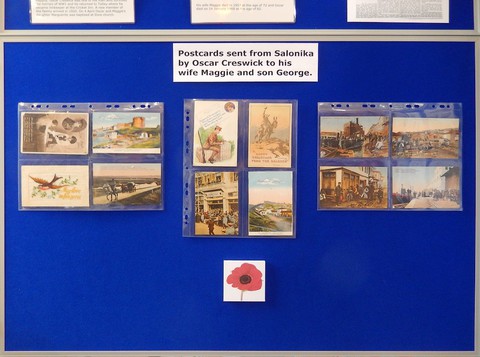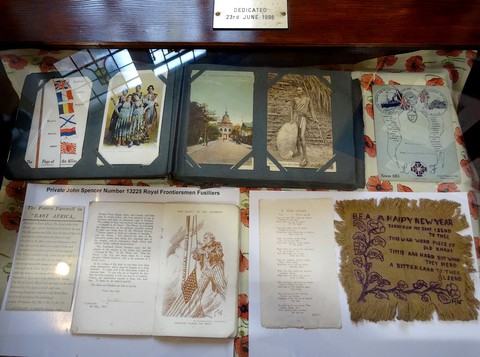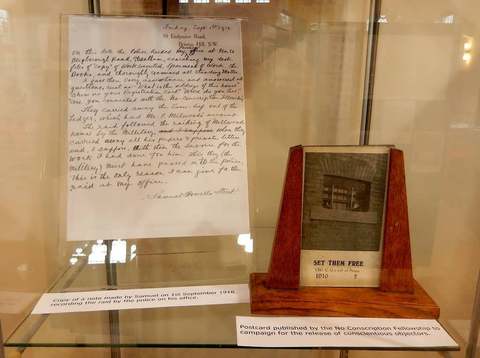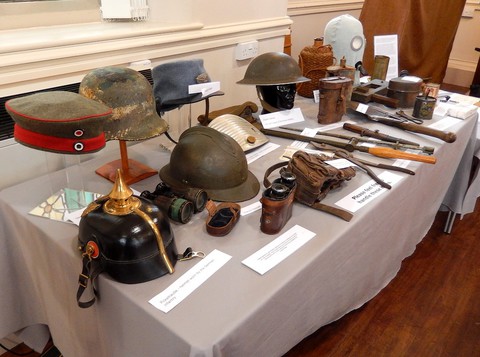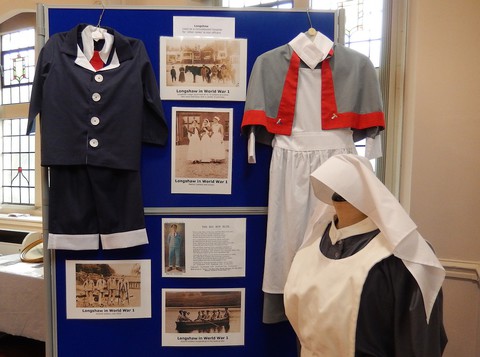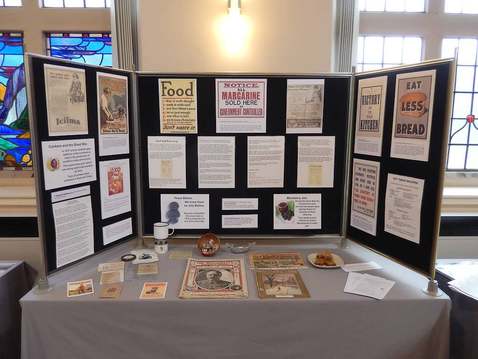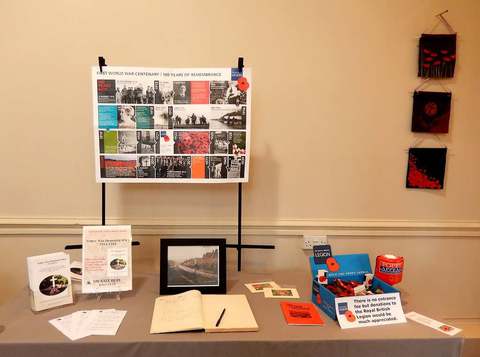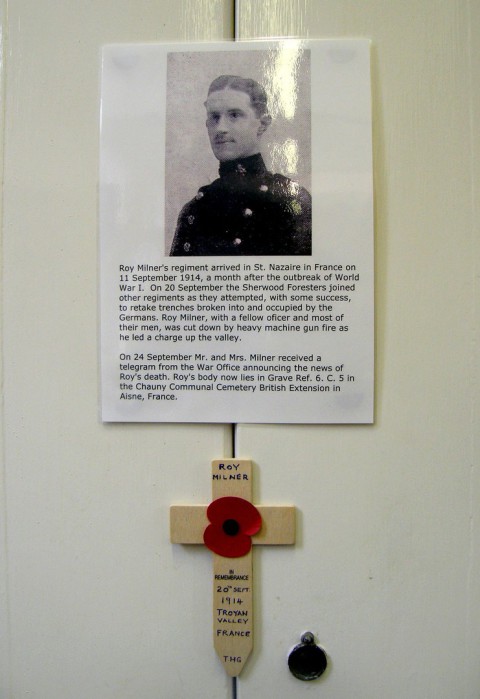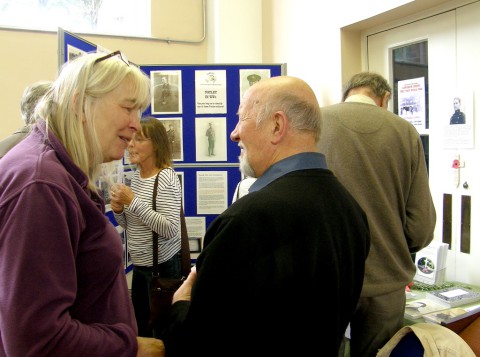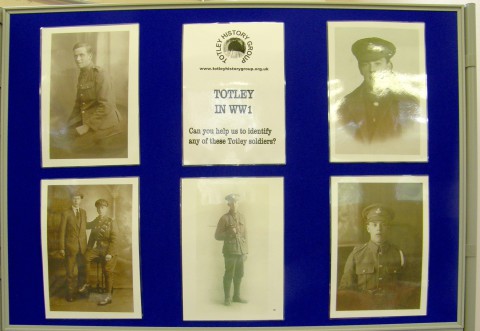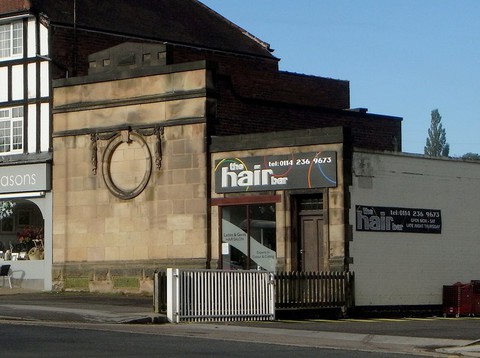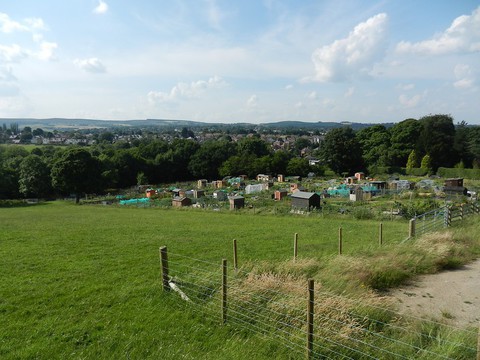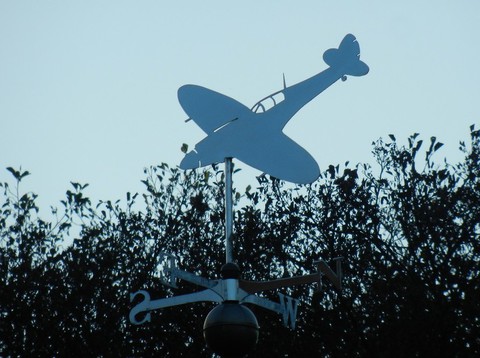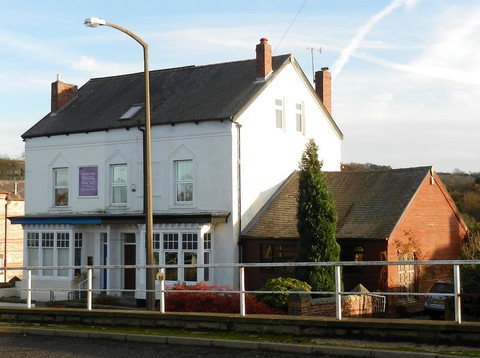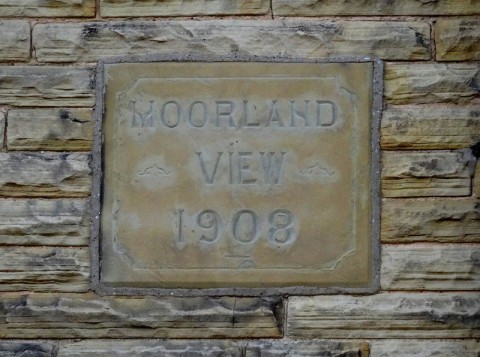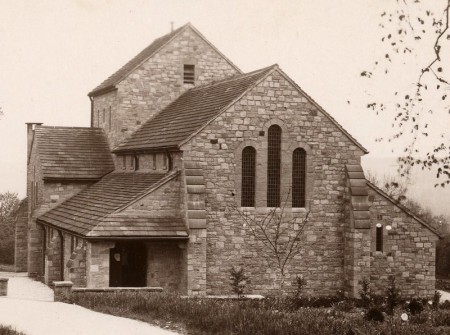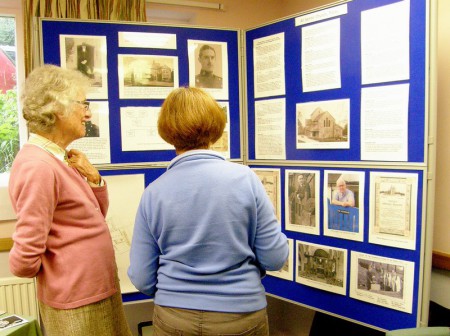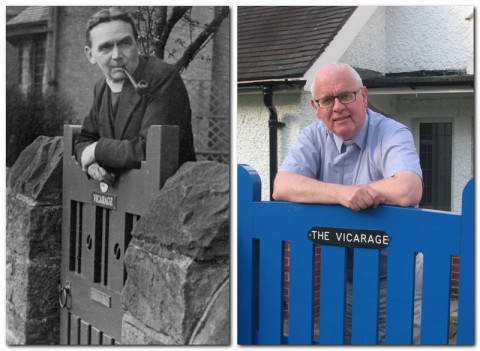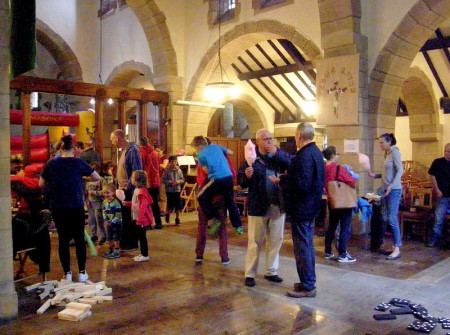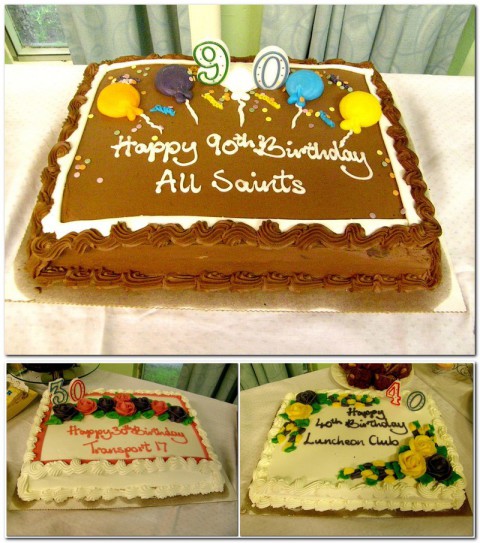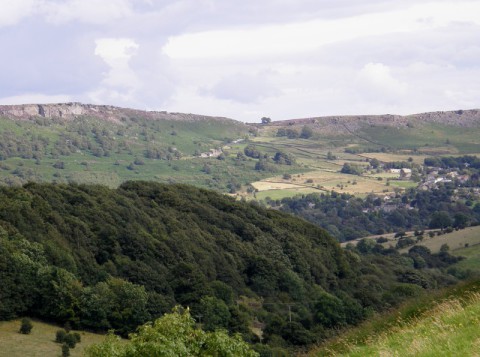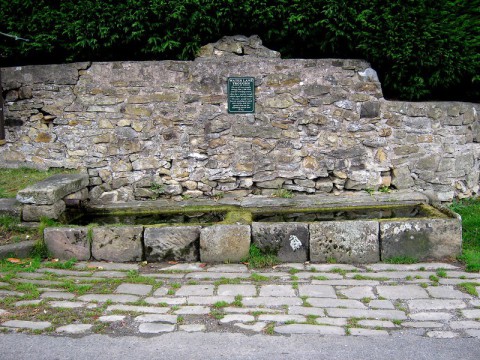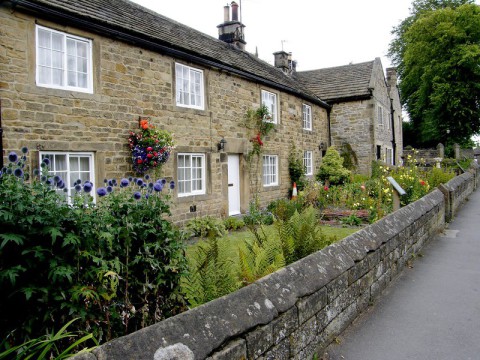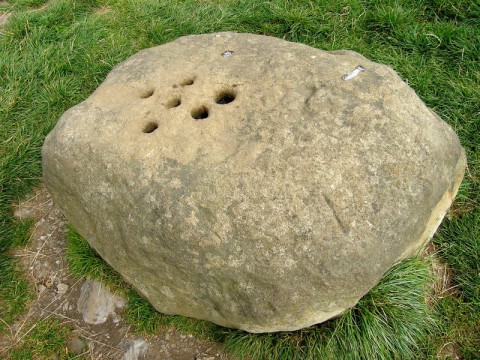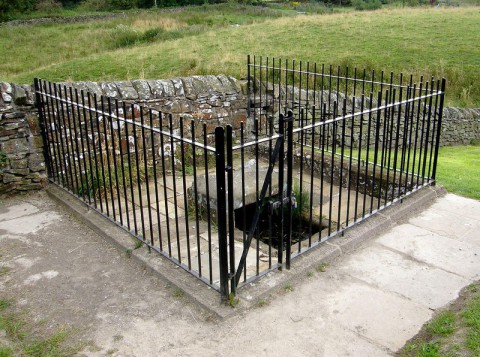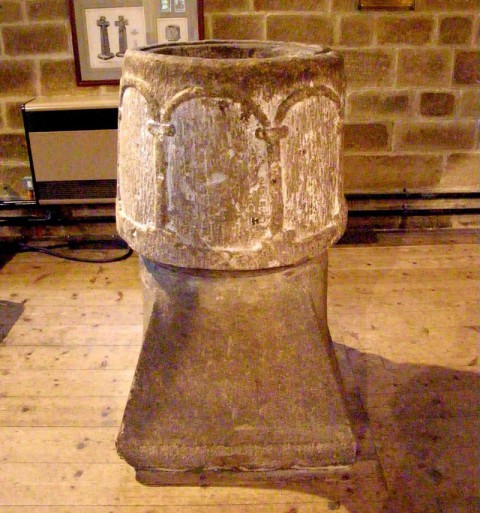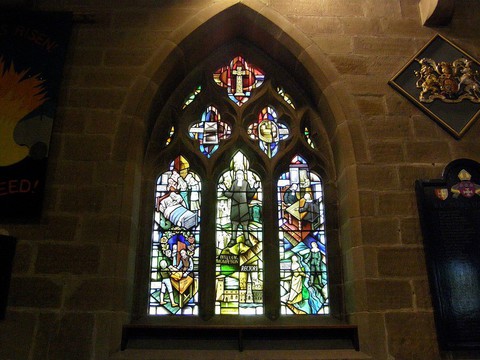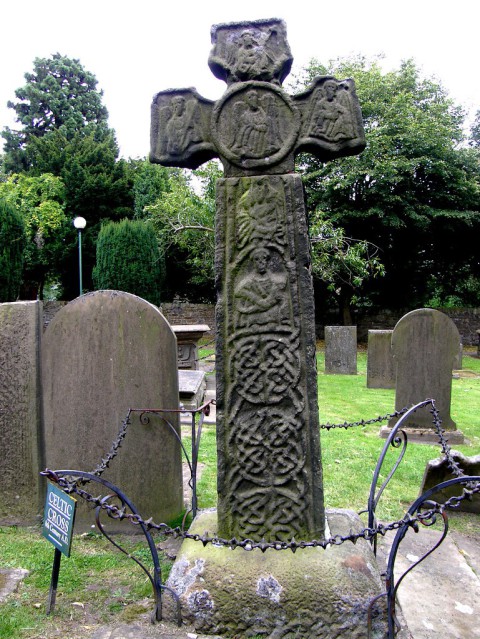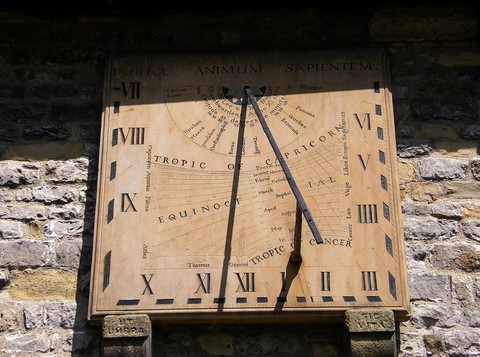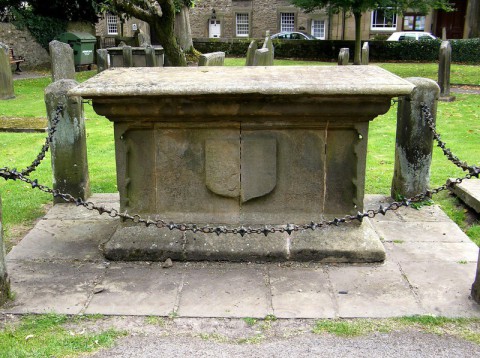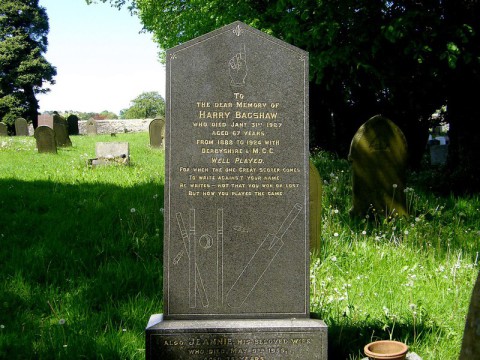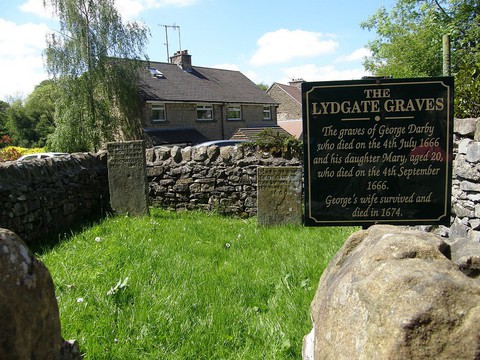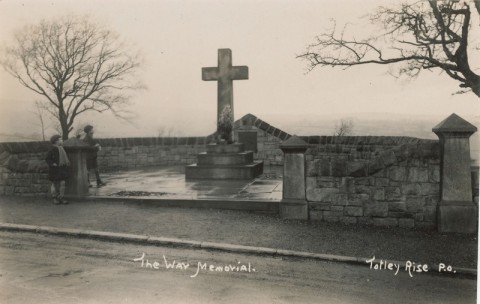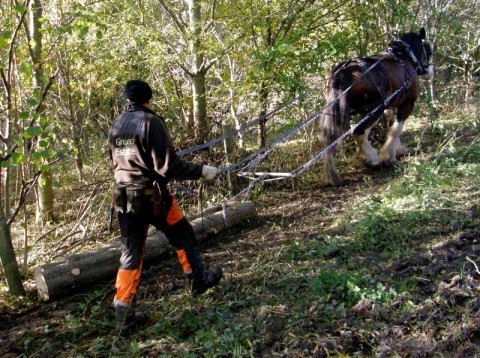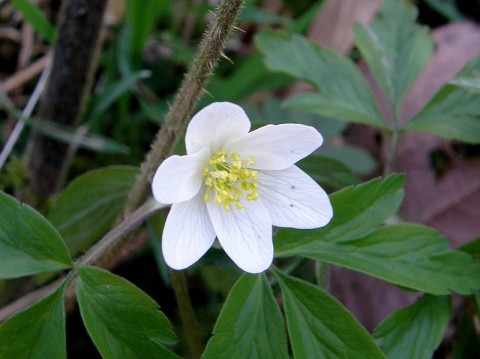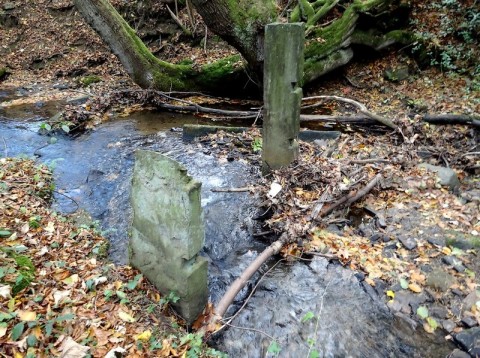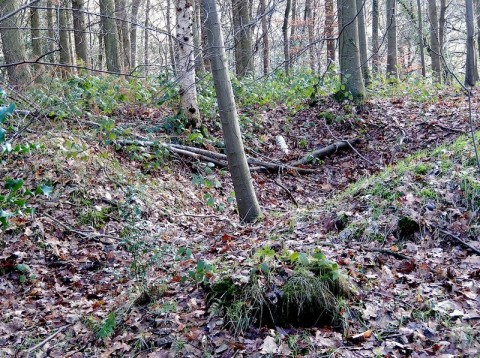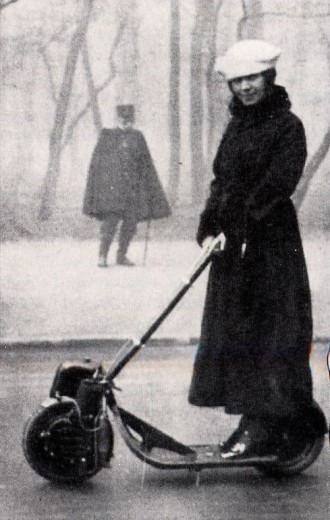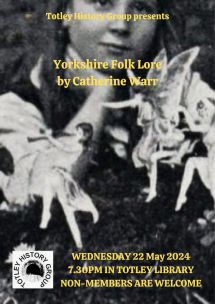Meetings and Visits in 2014
Totley in WW1 Exhibition at URC
8, 9 and 11 November 2014
The Totley War Memorial is no longer the bold focus for community remembrance of our war dead it was when it was first erected in 1920. In pictures from the time, the sandstone cross stands proud of the surrounding buildings and trees on Baslow Road, overlooking Summer Lane and was visible from most places in Totley. The monument is built on an extensive earth promontory and over the years the laurels that were planted to stabilise the bank have grown to surround the cross so that now it is held snuggly within a green cocoon. There are probably many local people who do not realise Totley has a war memorial and many more who have never visited it.
The one hundred year commemoration of the start of the First World War was an occasion Totley History Group members wanted to mark in some way. So when Dore and Totley United Reformed Church asked us to put on an exhibition, we jumped at the chance.
Considerable research had already been done by a few members of the group into the military careers of the First War soldiers named on the Totley War Memorial. Our intention for the commemorative exhibition was to widen its scope to include the soldiers who returned home and the community at home during the war. An appeal was made locally for artefacts and documents and a search across Sheffield brought in an exciting array of fascinating exhibits.
On the evening before the opening day we arrived at the URC with our bags and boxes and display boards and cabinets and set about creating the biggest and most ambitious exhibition Totley History Group has ever put on.
We were very touched that so many people lent generously from their precious family archives. The exhibition included, amongst many other things:
A letter that Bill Glossop's father, William wrote to his wife in which he asked her to keep him in mind with the children and to tell them that "..... I am very near and shall see them in due course."
From a number of sources we were lent tiny books of religious tracts and words of comfort designed to be carried in uniform pockets and handy in times of need. One of the books had been much thumbed and well read.
Local farmer, Oscar Creswick spent his war in Salonica and sent lots of picture postcards back to his family. His granddaughter, Mrs Patricia Borland lent us these precious pieces of her family history.
Carmen Blakeley lent the album kept by her father-in-law of his time serving in Africa. The album is far too fragile to be handled, but we were able to see the pictures as Carmen's neighbour had carefully scanned them all into a new album.
Jennie Street lent us a fascinating selection of letters and other documents about her grandfather. He was a conscientious objector and owned a printing press from which he published material in support of the cause. Newspaper reports and articles reveal the pressure the authorities put him under to cease his support. He carried on printing until the authorities destroyed his press.
A whole array of personal military equipment was lent to us by David Sandilands. A shovel, a pair of binoculars, a periscope, French, German and British helmets and much more. All could be handled as David takes his collection to schools to talk about war.
The Longshaw Estate lent us a reproduction nurses uniform they had used for their own First War commemoration exhibition and daintily embroidered silk postcards and a lovely family portrait were loaned by Mrs McDermott of Dore.
The special postal service between the mainland and the front line of the war served as a vital connection between the soldiers and their families and friends back home. As well as sending letters, wives and sweethearts baked Trench cake and Anzac biscuits to post out to their men folk. Although both treats were solid enough to survive being posted across the Channel, they do not taste as unappetising as they sound, and were probably very welcome to soldiers living in trenches with no home comforts. We had samples of both baked by History Group members and lots of visitors were brave enough to try them.
We know from the comments in our visitors' book that many people enjoyed and were moved by our exhibition. Totley History Group owes a debt of gratitude to all the people who trusted us with their precious family documents and artefacts without which we would have had no exhibition.
We would also like to thank Dore Village Society who were so generous with their loan of exhibition materials and display equipment. And thanks too to the lovely people at the United Reformed Church who kept everyone well supplied with tea and biscuits across the three days of our exhibition.
A collection was held for the Royal British Legion. We shall bring you the final amount raised as soon as we have the figure to hand.
More photos from the exhibition can be viewed at: Totley in WW1
Totley Show
20 September 2014
Mid September saw Totley History Group setting up an exhibition for the annual Totley Show.
The date coincided with the 100th anniversary of the death of Second Lieutenant Roy Milner, the first Totley soldier to fall in World War 1. At the end of the show the little cross was placed on the War Memorial.
There was considerable interest in our stand and we were busy chatting to members of the public all afternoon.
One of our visitors was able to identify the regiments of some of these soldiers. We know only that they are from Totley but so far they remain anonymous. There are clearer photographs in an album at: Totley's WW1 Soldiers. If anyone recognizes any of the soldiers we would be delighted to hear from you.
The photographs of Old Totley were very popular and brought back many memories to our visitors. As always, this was a very enjoyable afternoon.
19 July 2014
Totley Rise History Walk
Saturday July 19th saw a small but intrepid band of members gather outside the library in pouring rain. Undaunted we set off on a history walk around lower Totley led by Pauline Burnett. As Pauline pointed out the library itself is history having moved to its current location 50 years ago; from 1939 to 1964 it occupied the rather elegant stone building next to Tesco Express.
We then walked through Green Oak Park which was opened in 1929 by Mrs Sarah Milner of Totley Hall. At that time Pearsons' nursery was to the west and Colin Thompson's farmland to the south and east. On the other side of the park is the site once occupied by the prefabs, built mostly in 1945-46 as a quick fix for the post-war housing shortage. They covered much of the area that is now the upper part of Green Oak Road, Green Oak Avenue and Aldam Way.
By this time the rain had stopped and the sun was coming out! We walked on past the Scout Hut and on to White Lane also sometimes known as White Drive and Salt's Lane. From here we could see St. George's Farm, the site of John Ruskin's ill-fated experiment in self-sufficiency and communal living. The farm was eventually bought by George Pearson in the 1920s.
The length of the wet grass on the path up past the new allotments deterred us from walking up that way but we were able to see Mickley Hall which was built in 1867-68 to house the Cherrytree Orphanage. Originally founded in Sheffield by the Revd. Edward Ridge Taylor, it moved firstly to Highfield and then to Totley. In 1964 the trustees of Cherrytree agreed to the sale of Mickley Hall to the Cheshire Foundation and it now houses disabled people. Cherrytree moved into new purpose built premises higher up Mickley Lane.
We saw the old trackway called Totley Lane, which leads up to Hall Farm and Tinker's Corner in Bradway. We believe that Totley Lane once continued across the fields where the Shepley Spitfire now stands, below Rowan Tree Dell eventually to join Totley Hall Lane more or less opposite the Hall.
Dorothy then told the story that lies behind the name of Shepley Spitfire. The Shepley Family of Woodthorpe Hall lost three of their four children in World War 2. The third to die was Spitfire pilot Douglas Shepley, in August 1940, one of "The Few" who fought in the Battle of Britain. His mother and widow set about raising sufficient money to buy a replacement Spitfire. Local people rallied round magnificently and in August 1941 "The Shepley" joined 602 (City of Glasgow) Squadron.
When the new pub was built by Hardys and Hansons Brewery in 1979, local people were asked to suggest a name for it and the "Shepley Spitfire" was the name chosen. The splendid pub sign depicting Douglas Shepley and a Spitfire which had been removed for many months by H&H's owners, Greene King, has now been mounted close to the steps near the entrance. Another connection to the origin of its name is the silver Spitfire weather vane on the top of the clock tower.
Our route then took us past the old Chemical Yard where Tedbar Tinker and his partner Mr Siddall first manufactured chemicals in the 1840s. Crossing the footbridge by Ford Cottage we peered over into the Totley Brook below and were able to see the cobbles of the old ford. When the brook is very low the crossing is easy to see.
From there we walked up Back Lane past the long gardens of the demolished Wood View terrace to Bricky Row, thought to have been built for the navvies who worked on Totley Tunnel. Recent research, however, shows that they were built several years earlier probably in several phases.
After walking down to look at the Rolling Mill cottages and the source of the River Sheaf, formed by the confluence of the Oldhay and Totley Brooks, we walked back up the west side of the Baslow Road. On the bridge over the Oldhay Brook, by the Totley Rise Methodist Church, are the boundary stones between the parishes of Totley and Dore and also milestones which read "Bakewell 15 miles" and "Sheffield 5 miles". Paradoxically they are now very hard to read because of damage caused during recent repairs to the bridge.
As we continued up Baslow Road we stopped to look at the two properties on the south side of the road; one is now a dental practice and the other a private house. Originally they were a single house built for Joseph Mountain who, in 1891, had it converted to a hotel. When his application for a drinks licence was rejected, it became the the Queen's Temperance Hotel, and later a gentleman's club.
Behind this building were the Victoria Pleasure Gardens, on a large triangle of land between Baslow Road, Mickley Lane and the Totley Brook. Opened on Whit Monday 1883 by Mr Mountain, the gardens were intended to rival Manchester's Belle Vue; they finally closed in 1894.
From here we walked down Laverdene Road, crossing Mickley Lane into Lemont Road. The lovely row of terraced cottages on the south side were once surrounded by open fields when they were originally built in the late 19th and early 20th centuries.
Finally we walked up to look at the Greenoak Inn, built in 1812 to take advantage on the new turnpike which came up Mickley Lane and then on to Owler Bar and Stoney Middleton. Just above the inn stood the tollhouse.
As we walked back up to the library we all agreed that it had been an interesting and enjoyable walk. We were fortunate with the weather too as soon after we were safely home a thunderstorm broke.
If you would like to read more about this walk, there is a leaflet which can be downloaded and printed on a home printer. Follow the link to: Totley Rise Walk
7 June 2014
Totley All Saints Birthday Party
2014 sees the 90th anniversary of Totley All Saints' Church. Prior to 1924 Totley was a part of the parish of Dore & Totley with most local people being baptized. married and buried at Dore church. In the early 1920s it was decided that Totley should have its own church and moves were made to raise sufficient funds to enable this to happen. The land was donated by Mr. and Mrs. W. A. Milner of Totley Hall along with a donation of £2,000 in memory of their son Roy who was killed in France in September 1914. Many other local people donated large and small sums and eventually on 15 November 1924 the new church was opened and consecrated by the Bishop of Southwell.
Two other local anniversaries occur in 2014 also; the Luncheon Club is 40 years old and Transport 17 celebrates its 30th anniversary. On Saturday 7 June a joint celebration took place on what was, sadly, a rather wet and dull day. This didn't dampen the enthusiasm of those who came though.
Totley History Group had been asked to put on an exhibition based on the history of All Saints' Church and this attracted a lot of interest especially the photograph of the first vicar, Revd. R. Jermyn Hutton, standing at the gate of the vicarage. Next to it was a photograph of the current vicar, Revd. Paul Oakley, standing in the same place although the original gate has been replaced with a modern one. We also had a display telling the story of Roy Milner to whom the chancel of the church is dedicated.
Because of the inclement weather, many of the activities were moved into the church itself. Modern though All Saints is, this gave a real insight into how the interior of medieval churches looked and were used. The central area of churches in those times had no seating apart from benches around the walls for the elderly and infirm - the origin of the saying "the weakest go to the wall". The interiors of churches then were used for social activities as well as services.
In the Church Hall was an array of food including three splendid birthday cakes, one for each of the anniversaries. In spite of the weather this was a happy and successful occasion.
21 May 2014
Guided Tour of Eyam, The Plague Village
Our May event saw a group of us meeting in the plague village of Eyam in north Derbyshire for a guided tour by author and historian Ian Morgan. The weather was warm and sunny, a perfect day for an outing. Ian began by explaining than Eyam means ' place between streams' or 'at the islands'. It was not literally an island but an area of good farmland which was surrounded by badly drained marshes and boggy moorland. It was a very isolated village as it was not on the road to anywhere; if you arrived in Eyam you had gone there on purpose not by accident.
As a result there was a good deal of intermarriage which resulted in a genetic mutation in many of the villagers which is known as Delta 32. It is believed that this mutated gene gave immunity from bubonic plague. It seems that those not carrying the mutation died whilst those that did carry it went on to produce children who would also carry Delta 32. Even today, over 300 years after the plague, the villagers who are descended from the plague survivors still show an unusually high incidence of the mutation.
We began our tour by looking at the ruins of Bagshawe Hall, once the home of Colonel Bagshawe who in 1588 paid for water to be piped from the springs on Eyam Edge to series of public troughs with a number of private houses also being supplied. This was one of the first public water supplying systems in England.
As we walked down the main street of Eyam, Ian told us about several of the old buildings that we passed. When we reached the Plague Cottages we were told how the plague came to Eyam in September 1665, carried in on a roll of infected cloth which was delivered to the house of Alexander Hadfield, the village tailor. Alexander was away from home but his assistant, George Viccars, opened the pack of materials. A few days later George Viccars became ill and died; he was soon followed by Edward and Jonathan Cooper, the two young stepsons of Alexander Hadfield.
The plague spread rapidly; by the end of October it had caused 29 deaths. During the winter there were fewer deaths but in the spring of 1666 the death toll started to rise rapidly again. The local rector William Mompesson and his predecessor Rev. Thomas Stanley persuaded the villagers to agree to a strict quarantine to prevent the plague spreading to other villages and towns in the North Midlands. The Earl of Devonshire and others from the surrounding area provided the villagers with food and other necessities, leaving the goods at the village boundary stones or at Mompesson's Well, which stood high above the village.
From the Plague Cottages we moved on to the churchyard where Ian told us something of the church's history before we went inside to look around. The parish church of St. Lawrence dates back to the 12th century and stands on Saxon foundations. The interior has a Saxon font, and some interesting medieval wall paintings.
There is also a rather splendid chair which belonged to William Mompesson and a Plague Register which lists all 260 victims of the plague with their dates of burial. A recent addition to the church in 1985 is the beautiful stained glass Plague Window which tells the story of the plague in Eyam.
During the self emposed quarantine the church was completely closed both for services and for burials. William Mompesson held services and preached in the open air and people were told to bury their own family members in their garden or a nearby field.
Outside once more Ian showed us some of the interesting features in the churchyard. A splendid eighth century Celtic cross stands in front of the church. It is one of the finest in the country and a Grade I listed structure.
Above the Priest's Door of the church is a superb sundial. Made in 1775, it was originally over the main entrance to the church but was moved to its present position in 1883. Not only does it tell the local time but various places in the world are recorded around the gnomon near to the top of the dial. As the shadow passes over a name it indicates noon in that location.
Ian then showed us two very different gravestones, the first being that of Catherine Mompesson, wife of William, who died of the plague in Auguest 1666. She is the one exception to the ban on burials in the churchyard during the quarantine period. At the end of August each year a wreath of red roses is placed on her grave.
The other grave is that of cricketer Harry Bagshawe (1859-1927) who played for Derbyshire between 1887 and 1902. Between 1907 and 1923 he was a first class umpire. What an apt and splendid headstone!
From the church we walked down to the main square and then up Lydgate to the site of the Lydgate graves where George Darby and his daughter Mary are buried. This was the final stop on what was a really enjoyable and interesting tour. Ian was an excellent and informative guide who showed us not only the main plague sites but also several other lesser known facets of Eyam. Several members of the group stayed on and had lunch in Eyam and then explored the village more thoroughly in the afternoon. The perfect weather and a fascinating location combined to make this a splendid day out.
26 February 2014
Open Meeting
A good number of us gathered in Totley library for our open meeting. A report from Pauline on the research into the Totley Rise shops got the meeting off to an interesting start. Pauline told us she has uncovered some evidence that challenges the local story that the houses on the Rise were built for the railway navvies. Her evidence appears to show that they were built before the railway came. The key to establishing the correct date for these houses is to be found in the trail of ownership of the strip of land between Baslow Road and the Totley Brook. Pauline hopes that the sale of leases and other indirect means of identifying ownership will provide enough evidence to establish for certain when the houses were built.
It was suggested at the meeting that it might be productive to investigating present day land ownership and trace back from there. We look forward to hearing more about Totley Rise shops and their history. If you have any documents, information, pictures or family stories about the shops, Pauline would like to hear from you.
We are in the commemorative year of the start of the First World War and discussions have been held about how we might mark this event. It has been proposed by the Totley United Reformed Church that Totley History Group mount an exhibition at the church to coincide with the Armistice on the 8th and 9th of November. The aim of the exhibition would be to reflect the impact of war on the whole community; those who left to fight and those who stayed at home. We have focused our researches in recent years on the stories of the local men who were killed in the conflict, and without forgetting them, we would like to broaden our view to include the whole community. How did the Totley community cope during the conflict? Were there food shortages and other deprivations? Many agricultural communities had their horses seized for work at the front. Did this happen in Totley? An appeal will be made shortly to the local community for stories, photographs and memorabilia from the first war.
It has been proposed that the laurels which now surround the platform on which the Totley war memorial stands, should be cut back or removed. Enquiries have been made to the War Memorial Commissioners to establish landownership of the land on which the memorial is built, as the landowner's permission would be needed before any work could be carried out. Some help with finance for this venture might be available for the Commission and the remainder would be raised locally. THG will work with other local groups and Totley Residents' Association on this project.
Over tea and coffee we passed around class photographs from All Saints' School; of the Wint and Bestwick families and of Hannah Wild, the school mistress of the first school in Totley. Lots of memories were sparked by the class photos. We would like to find out more about the two schools in Totley and if you have any pictures of either Totley schools we would be very interested to see them. Can you remember your classmates names? Your teachers? Do get I touch through the contact link.
22 January 2014
The Story of Gillfield Wood
We all crammed into Totley library on the evening of Wednesday 22nd January to hear Sally Goldsmith talk about the results of the archaeological survey carried out by the Friends of Gillfield Wood.
So what do you call Totley's ancient wood? You have plenty of names to choose from. Gillfield? Gillyfield? Jillfield? I'm not sure which name got the most votes at the beginning of Sally's talk, and
even if I was sure, I expect more than a few other local names were missed. Whatever you call the wood, it's archaeological significance has been established with the detailed survey recently
completed by the Friends of Gillfield Wood.
The survey was funded with a Heritage Lottery grant and enabled the FOGW to employ experts as mentors for the army of local volunteers who carried out the woodland survey and research.
Sally told us that in previous times Gillfield Wood covered a larger area than it does today. In aerial photographs the ghost of this larger wood is clear to see in the pattern of present day field hedges. The first recorded mention of the wood was in 1561 when it was owned by George Talbot, 6th Earl of Shrewsbury. This date and the presence of ancient wood indicator plant species like bluebells and wood anemones, establishes Gillfield Wood' s credentials as an ancient wood.
Sally painted us a picture of Gillfield Wood as a working environment, owned by a succession of landlords who fully exploited its potential to make them money. The wood we know today was cleared and replanted in the 1940s and so it takes a leap of imagination to see the coppicing, lead smelting, bark stripping and white coal production that dominated its life in earlier times. The physical evidence for many of these activities were uncovered by the survey. For example, when trees are coppiced they are cut back to the ground every 10 years or so. This forces the tree to spring back into growth with multiple stems. Walking through Gillfield Wood today you might be able to spot these old coppiced trees with their multiple trunks. Relics of a past time.
More than thirty Q shaped depressions were found in the wood and are thought to be the result of white coal production. No one is now sure what exactly white coal is or how it was produced, but it apparently burns hotter than regular fire wood but less fiercely than charcoal and was an essential ingredient for lead smelting. These Q pits are all that remain of an industry that dominated the landscape for centuries.
In more recent times, the Milner family of Totley Hall owned the wood and used it as their woodland playground. The foundations of their shooting parties' woodland shelter has been found, and you can still walk around the top of the walls of the swimming pool they dug, (long out of use and filled with leaves and river sludge). A curious find in the wood from this period was part of an Autoped, a motorised scooter popular at the beginning of of the last century.
In addition to the physical woodland archaeology, documents such as diaries, letters, contracts and maps have been searched for information about the history of the wood. These sources give us insights into the way the wood was managed and the local people involved in the wood.
Altogether the FOGW survey found and recorded over 500 plants and man-made structures of archaeological interest. To find out more about the survey and how to get involved, visit the Friends of Gillfield Wood website at www.friendsofgillfieldwood.com
So what of the future? More investigations into the survey findings are planned. FOGW and Sheffield City Council are working together on woodland maintenance and improvement and there are plans to open up some glades in the wood to encourage more plant diversity. FOGW welcome new members. Contact them and you can get involved in the past and the future of Gillfield Wood.
You may also like to download Sally's excellent paper on The Story of Gillfield Wood
by Sally Goldsmith
The Story of Gillfield Wood.pdf
Adobe Acrobat document [2.9 MB]
Search Our Website Here
Future Meetings
April
May
June
Unless stated otherwise our meetings are held in Totley Library on the 4th Wednesday of each month at 7.30pm.
Pauline Burnett's book The Rise of Totley Rise has been revised and updated. It tells the story of this small piece of land from 1875 when there was only a rolling mill and chemical yard alongside the river a mile from Totley, through Victorian and Edwardian times, two world wars and up to the present day. It has 94 pages including a useful index and many illustrations from private collections. The book is available now from Totley Rise Post Office priced at £5, or through our website when an additional charge will be made to cover packing and postage.
A few copies are still available of Sally Goldsmith's book Thirteen Acres: John Ruskin and the Totley Communists. Totley was the site of a utopian scheme funded by art critic and social reformer John Ruskin. In 1877 he bought 13-acre St. George’s Farm so that nine Sheffield working men and their families could work the land and, to keep themselves busy, make boots and shoes. Sally tells an engaging story from our history with a quirky cast of characters including Ruskin himself, the poet and gay rights activist Edward Carpenter and Henry Swan, a cycling, vegetarian artist and Quaker. The book is available to order online from the The Guild of St. George by following this link.
A recently discovered box of WWII correspondence reveals the story of how a small group of ladies from Dore and Totley recruited knitters from the west of Sheffield and how their efforts made them the country's greatest provider of Comforts for the Minesweeping crews of the Royal Navy. The story is told in Knit For Victory, a new book from Totley History Group. Written by Pauline Burnett, it has 82 pages and many illustrations. It is on sale in local shops and via our website. Further information about the correspondence is in this inside page of our website: Dore & Totley Minesweeping Trawlers Comforts Fund.
The story is told in Totley War Memorial WW1 of the ten men from our village who gave their lives in the Great War. Written by Pauline Burnett, Jim Martin and Dorothy Prosser, a chapter is devoted to each of the soldiers with a family tree followed by as much information as could be discovered about the men and their families. There is also information about their military careers and the actions in which they lost their lives. The book has 64 pages and is illustrated throughout with photographs of the men, their families and the houses where they lived.
Totley All Saints' Church Parish Magazines for the years 1985-2006 with notices of baptisms, marriages and funerals and accounts of spiritual, educational, charitable and social matters in the village. Scanned in full, including advertisements from local traders.
In 1893 during the building of the Totley Tunnel there was an outbreak of smallpox amongst the navvies which spread to some of the local population. 17 people were buried in communal graves in Dore Churchyard, 6 from "Green Oak" (Lemont Road). The severity of the outbreak was principally caused by overcrowding and insanitary conditions in lodging houses .
Kathleen Grayson was a 39 year old housewife when WW2 broke out. She volunteered for the ARP and became an ambulance driver. During an air raid on Sheffield in July 1941, and despite her own injuries, she managed to get a seriously injured casualty to hospital. For this she was awarded a commendation from King George VI. Together with her friend Hilda Duffy, Kathleen also assembled a team of knitters to provide essential warm clothing for the men serving on the minesweepers patrolling the North Sea.
We have recently bought at auction the WW2 memorabilia of Douglas Platts whose family home was at Hillside, 98 Queen Victoria Road. After the war Douglas returned to his civilian occupation working in the family scissors manufacturing business. He lived in our area for the rest of his life.
We are very grateful to Mrs Valerie Taylor of Dore for lending us the title deeds to Lower Bents Farmhouse which is reputed to be the oldest surviving building in the area with a proven history back to 1621. We have now scanned and transcribed the deeds which could be particularly interesting to anyone with a connection to the local Fisher, Dalton and Marshall Families.
Until 1844, when Dore Christ Church parish was created, Totley township was part of Dronfield parish. We have now transcribed the burial records for former Totley residents at St. John the Baptist, Dronfield for the period 1678-1870 and at St. Swithin, Holmesfield for the period 1766-1901.
Whilst researching the history of the Dalton Family we found it useful to transcribe a number of early Wills and Inventories. These and those of many other Totley, Dore and Holmesfield people dating from between 1594 and 1856 have now been added to our website.
St. Swithin's Church, Holmesfield pre-dates Dore Christ Church and was the place where many of the people from Totley worshipped and were baptised, married and buried. Read the inscriptions on more than 750 gravestones in the churchyard including those of Mr. and Mrs. William Aldam Milner of Totley Hall, Jessie Matilda Tyzack (nee Fisher) of Avenue Farm, and Rev. J. A. Kerfoot of St. John's, Abbeydale.
Thomas Youdan was a music hall proprietor and benefactor who was living at Grove House, Totley in 1867 when he sponsored the first football knockout competition in the world for The Youdan Cup.
The words Millhouses Cricket Club can be seen in the background of team photos which are likely to date from between 1905 and the early 1920s, very probably pre-war. They were lent to us by Garth Inman who can identify his great uncle, Cecil Inman, in some of the photos and would like to know when they were taken and, if possible, the names of others present. Please take a look to see whether you can put names to any of the faces.
Josiah Hibberd was seriously injured whilst working on the construction of the Totley Tunnel in 1892. He died on 9 May 1897 at the age of 38 having apparently spent most of previous five years in hospital.
Bradway House was built around 1832 by Henry Greaves, a farmer, together with two adjacent cottages. We have traced most of the occupants of the property from these early days up to the start of World War Two.
We have transcribed the baptisms records at St. John the Evangelist, Abbeydale from when the church was consecrated in 1876 until just after the start of World War 1. The records are arranged in alphabetical order based upon the child's name and show the date of baptism, the names of the parents, their home location and occupation.
Nick Kuhn bought an original 1920s poster which had this owners' blind stamp in one corner. The stamp almost certainly refers to a house named Wigmore that was built in the late 1920s or early 1930s. The first occupiers that we can trace are John Howarth Caine, a district mineral agent for the LNER, his wife Florence Jane (nee Prince) and daughter Doris Mary. The Caine family lived at Wigmore until 1936 by which time the house would have been known simply as 12 The Quandrant.
George Griffiths died on 13 December 1888 following an explosion during the sinking of number 3 airshaft at Totley Bents. His widow Florence died shortly afterwards and his two daughters Maud and Annie were adopted separately. Whilst Annie lived the rest of her life in Yorkshire, Maud emigrated to Australia in 1923 with her husband, John Burrows, daughter Margaret and son Jack, pictured above.
George Wainwright was said to have been born in Bamford, Derbyshire in 1714. He learned the trade of linen weaving and moved to Totley after his marriage on 1744. He became an ardent follower of John Wesley who paid many visits to Sheffield and who would have passed through or close to Totley. Preaching was at first conducted out of doors and when Wesley's preachers became harassed by a mob of Totley ruffians in 1760, George offered them safety of his own home. He remained a Methodist for all of his long life, dying in Dore in 1821 at the reputed age of 107.
Oakwood School was started by Mrs Phoebe Holroyd in 1925 initially as the Firth Park Kindergarten and, by 1927, as the Firth Park Preparatory School. Phoebe was still working at the school almost fifty years later when she was well into her seventies. We would like to hear from anyone with memories of the school.
James Curtis was born at sea aboard HMS Chichester in 1790. He enlisted as a Private in the 1st Grenadier Regiment of Foot Guards in Sheffield in 1812 and served in Spain and Portugal during the Peninsular War. He later fought in France and Belgium taking part in the Battle of Waterloo. In later life James lived at the Cricket Inn where his son-in-law William Anthony was the licensed victualler. He died in Heeley in 1882 aged about 91.
Charles Paul lived in Totley in later life. He was a local historian and archaeologist who was an authority on the history of Sheffield, especially the two areas he knew best: Attercliffe and Ecclesall. His books and letters to local newspapers were published under the Latin form of his name Carolus Paulus.
Towards the end of the 19th century Totley Hall gardens became a well known beauty spot that attracted many hundreds of visitors from Sheffield on open days and the rock gardens became one of its most popular features. Mrs Annie Charlesworth sent us six glass transparencies of the rock gardens taken, we believe, in the early years following the Great War.
Anton Rodgers send us photographs of three water-colours that had been bought by his grandfather at a sale of the contents of Abbeydale Hall in 1919. One was of a scene said to be in York by A. Wilson. A second was of a seated child with a dog believed to be pianted by Juliana Russell (1841-1898). The third was of Lake Como, by Ainslie Hodson Bean (1851-1918) who lived for much of his life on the Riviera and in North Italy.
A Canadian correspondent sent us photographs of a set of silver spoons that were bought in a small town in British Columbia. The case contained a note signed by Ebenezer Hall indicating that they were a wedding gift to Maurice and Fanny Housley. We think we may have traced how they got to Canada and where they might have been since.
Green Oak Park was opened on 23 March 1929 on land that had been bought by Norton District Council from John Thomas Carr, a farmer and smallholder of Mona Villas. In later years, the buildings were used by the Bowling Club (the green having been built in 1956) and by the park keeper. However, the buildings appear to have been constructed in several phases, the oldest of which predates the park to the time when the land was used for pasture.
We believe the old Totley Police Station at 331 Baslow Road was built around 1882. Two lock-up cells were excavated just below floor level in the summer of 1890. We have traced the Derbyshire Constabulary police officers who lived there from John Burford in 1886 to George Thomas Wood who was there when Totley was absorbed into Sheffield in 1934.
David Stanley lived in Totley Rise in the later years of his life. Born in Bulwell, Nottinghamshire, he joined the 17th Lancers when he was 19 and rode in the Charge of The Light Brigade at the Battle of Balaclava where he was seriously wounded. For the first reunion of veterans in 1875, he told his story to a reporter from the Buxton Herald.
This picture postcard was addressed to Miss Abell, Holly Dene, Totley Brook Road and posted in Rotherham on 10 December 1907. Edith Annie Abell was born on 4 February 1887 in Sheffield and her family came to live in our area in the 1900s, staying for the rest of their lives.
Charles Herbert Nunn enlisted in the British Army on 23 August 1915 and was sent to France on 18 December 1915 to served with the British Expeditionary Force. In March 1916 it was discovered that he was underage and he was returned home. Shortly after his 18th birthday he re-enlisted and was again posted abroad where, in addition to this trio of medals, he was awarded the Military Medal.
This certificate was awarded jointly by the Red Cross and St. John's Ambulance to Isaac Henry Williams, of Lemont Road, for his services during WW1 as a stretcher bearer. We are seeking anyone who can help us pass it on to a living relative.
In 1832 Samuel Dean pleaded guilty to stealing a quantity of lead from the Totley Rolling Mill and was sentenced to seven years transportation to Australia. He sailed on the Mangles and upon arrival in New South Wales he was sent to work for William Cox, the famous English explorer and pioneer. After receiving his Certificate of Freedom in 1840, Samuel became a farmer and went on to have a very large family. Samuel was born in Whitechapel around 1811 to parents Samuel Dean Snr. and Susannah Duck. His descendant Sarah Dean would like help in tracing his ancestry.
Ellen Topham was born in 1889 in Nottingham. Her parents had been living together since 1862 but had never married so it was most unusual that, after their deaths, Ellen was accepted into Cherrytree Orphanage. Even more so since her father, Snowden Topham, had been acquitted somewhat unexpectedly in a widely reported manslaughter trial. Ellen remained at Cherrytree until her death from pulmonary tuberculosis at the age of 15.
Mabel Wilkes was a resident in Cherrytree Orphanage between 1897 and 1905. Her granddaughter Sally Knights sent us these images of a book presented to Mabel as a prize for her writing. Sally also sent us some personal memories of her grandmother and a photograph of a locket which contains portraits of Mabel and her husband Septimus Gale.
John Henry Manby Keighley was living at Avenue Farm when he enlisted in 1916. He fought in France with the Cheshire Regiment but after home leave in early 1918 he went missing. The Army were unable to determine whether he had deserted or returned to the front and been either killed or captured by the enemy. In August 1919 he was formally presumed killed in action but it appears he did not die but returned home to his family.
Horace Ford was admitted to Cherrytree Orphanage on 26 October 1888 at the age of six. He left at the age of 14 to become an apprentice blacksmith and farrier. Soon after his 18th birthday Horace enlisted in the Imperial Yeomanry to serve his country in the war in South Africa. His letter home to his Orphanage mentor tells of the lucky escape he had in battle.
Pat Skidmore (née Sampy) lived on Totley Brook Road from 1932 to 1948 before her family moved to Main Avenue. In this short article she remembers her time at Totley All Saints School where she was a contemporary of Eric Renshaw and Bob Carr.
As we have nowhere to exhibit memorabilia and artifacts, we have created a Virtual Museum instead. The latest addition to our collection is this double-sided Totley Rise Post Office oval illuminated sign which was on the wall of 67 Baslow Road before the Post Office business transferred to number 71. Please contact us by email if you have things that you own and would like to see added to the virtual museum.
Conway Plumbe was a man of many talents who came to live in Totley Rise around 1912. As a young man he had poems published by Punch magazine and is remembered in modern collections of WW1 poetry. A number of his paintings were accepted by the Royal Academy. An engineering graduate of London University, he joined the Civil Service where he rose to a high level as a factory inspector, publishing two books on the subject and giving a series of talks on workplace health and safety on BBC radio during WW2. In retirement he wrote a philosophical-spiritual work called Release From Time.
Inside Totley Rise Methodist Church there is a Roll of Honour commemorating the soldiers from its congregation who served their king and country during the Great War. For all but one of the 28 names the soldier's regiment is recorded in the next column. The exception is David Cockshott for whom 'killed in action' is written alongside yet he appears on no war memorial in our area and no record of a mortally wounded soldier of that name is to be found. We think we have solved the mystery.
Mrs. Kate Plumbe moved from Mansfield to Totley Rise with a number of her family in 1913 and became closely involved with the Totley Union Church. Her daughter Winifred became a missionary and headmistress in Calcutta for over 38 years following which she returned home to live with her sister Hilda on Furniss Avenue. Hilda had also been a teacher, missionary and, like her mother, a volunteer at St. John's VAD during WW1.
Thomas Glossop was a cutler and razor manufacturer who was well known amongst cricketing and gardening circles. Despite going blind, he was able to continue his hobbies with remarkable success
The Totley Union Cycling Society Prize Giving and Fete was held on the fields near Abbeydale Hall on 18 July 1914. Anne Rafferty and Gordon Wainwright have named some of the people in two wonderful photographs of the event. Can you identify any more for us?
The Tyzack family are well known in our area for owning iron and steel trades at Walk Mill, Abbeydale Works, Totley Rolling Mill and Totley Forge. This article covers the history of the family from the late 18th century when William Tyzack the founder of the company was born until the early 20th century when Joshua Tyzack farmed at Avenue Farm, Dore.
Walter Waller Marrison moved to Totley around 1897 with his wife and their two young sons. He was a house builder who constructed properties around Totley Brook and Greenoak before ill health forced him to take up less physically demanding work. In 1904 he took over the tenancy of the grocers and off licence at number 71 Baslow Road. After his death in 1908, his widow Kate and later their eldest son Jack continued to run the business until it was sold in 1934.
Ron Wijk of Nieuw-Vennep in the Netherlands has sent us two scanned images of drawings of old cottages made by the celebrated Dutch painter, Anton Pieck (1895-1987) simply annotated "Totley", and wondered whether we could identify their locations.
We would like to thank Christopher Rodgers for bringing to our attention this fascinating log of the 85th Sheffield (St. John's and Totley Orphanage) Wolf Cub Pack for 1927-45. The log is published jointly by Sheffield Scout Archives and Totley History Group as a free PDF download. It is illustrated by no fewer than 92 photographs and is supported by a comprehensive index and biographies of some of the main participants.
Following our Open Meeting event on School Days, Roger Hart, Howard Adams and John Timperley have each written to us with their memories of Norwood School, which was located in the rooms attached to the Dore & Totley United Reformed Church on Totley Brook Road.
On 22nd July 1909 the children of Dore and Totley Schools celebrated by a pageant the union of England under King Ecgbert which took place at Dore in AD 827. The pageant was devised and written by Mrs Sarah Milner and her daughter Marjorie and performed in a field close to Avenue Farm in front of a large audience. Photographs of the event survive together with a fragment of the script.
John Edward Greenwood Pinder had lived all 46 years of his life in Totley but on census night, Sunday 2 April 1911, he was not at home; he was in Derby Gaol serving a sentence of three months hard labour. From the age of 20, John had been in and out of local courts for a series of minor offences including drunkenness, assault, wilful damage and night poaching. Finally he was sent to gaol for cutting down and stealing 86 small trees which he sold in Sheffield market for Christmas.
We have already transcribed the census returns for Totley, Totley Rise and Dore. Now we have transcribed Census Strays. These are people who were born in Totley but are missing from our earlier transcriptions. They may have been living, working or studying elsewhere or just away from home on the night the census was taken. Two people were in prison. Others were in Union Workhouses, hospitals and asylums. Fully indexed strays from the 1851, 1861, 1881, 1891, 1901 and 1911 censuses are available now.
We wish to thank Gillian Walker for allowing us to digitize an archive of material about the 1st Totley Scout Group. Most of the material was collected by Arthur Percival Birley in the period 1949-51 and there are many interesting documents pertaining to the building of the scout hut on Totley Hall Lane. In addition four Newsletters survive, two from the 1940s and two from 1971.
We are grateful to Angela Waite and All Saints' Parish Church for giving us access to baptismal and kindergarten birthday rolls dating from 1926 to 1941. We have transcribed the names, addresses, birthdates and baptismal dates and created an alphabetical index of entries for you to search.
Edmund Sanderson, a Sheffield estate agent, aquired the land on either side of the old drive to Totley Grove in 1874 and divided it into plots for development. He called it the Totley Brook Estate. But before many houses were built, the estate road was severed in two by the building of the Dore & Chinley Railway line. The eastern end of the road became the cul-de-sac we now call Grove Road.
John Roberts was born in Sheffield in 1798. He became a partner in one of the leading silversmiths firms in the city before moving to Abbeydale Park in 1851 and extending the house in Victorian gothic style. He paid for the building of St. John's Church and was believed to dispense more in charity than any other person in the neighbourhood including his protege Ebenezer Hall.
The Coke Family owned the Totley Hall Estate from 1791 to 1881. With the aid of a family tree to guide us, Josie Dunsmore takes us through the story of their tenure.
When the Rev. D'Ewes Coke inherited the Totley Hall Estate in 1791 it had two farms. Josie Dunsmore tells the story of how the two farms were combined under the tenancy of Peter Flint with the aid of field maps drawn by Flint himself and later by the Fairbanks family.
Do you think you recognize this face? More than sixty photographs of the girls and teachers at Hurlfield Grammar School for Girls in the 1940s were given to Totley History Group by Avril Critchley, who was herself a student at the school. The collection includes fifteen form photographs from June 1949. There would have been a number of girls from the Totley area attending the school in those days.
Christine Weaving tells the story of her 2 x great uncle George Edward Hukin, a Totley razor-grinder, and his life-long friendship with the academic, poet, writer, and free-thinker Edward Carpenter.
Eric Renshaw (pictured here on the right with Bob Carr) grew up and lived in Totley from 1932 to 1960. Many of his memories are of a sporting nature.
We are very grateful to Gordon Grayson for giving us this splendid sale document for the Norton Hall Estates, following the death in 1850 of Samuel Shore. The estates included a large part of Totley and the document has maps and illustrations, plus schedules of land and property with the names of tenants. We have also added a transcription of the entries for Totley and Dore.
Watch this Youtube video of the talk given by Dr. Mark Frost and Sally Goldsmith on Ruskin, Totley and St. George's Farm. The talk was hosted by Totley History Group on 20th May 2015 as part of the Ruskin in Sheffield programme. Also enjoy a video of the outdoor performance Boots, Fresh Air & Ginger Beer written by Sally.
When Jacqueline A. Gibbons became interested in what made her father tick, it began a journey through WW1 archive records and led to her flying from Toronto to visit the house and village where he lived and the countryside that he so much enjoyed. Jacqueline reminds us that in the early 20th century Sheffield was a driving force of industry and that Totley was the place where many of its remarkable people lived and where they formulated their ideas.
Edgar Wood was the designer of The Dingle, 172 Prospect Road, built in 1904 for Rev. William Blackshaw, the founder of the Croft House Settlement. The house, together with its western terrace and boundary walls, has now been awarded Grade II listed building status.
What was probably "the most perfect little garden railway in existence" in 1910 was to be found in the grounds of Brook House, Grove Road, the home of its designer and constructor, Guy Mitchell. Look at some wonderful photographs and read reports in newspapers and a full appreciation in Model Railways magazine.
We have now completed our transcription of Totley School's Admission Records for the period from 1877 to 1914. There is also a useful index to the names of the scholars and to their parents or guardians. We are very grateful to Sheffield Archives and Local Studies Library for allowing us to transcribe and publish these records and for permission to reproduce the photograph of a specimen page of the register.
On 8, 9 and 11 November 2014 Totley History Group held an exhibition at Dore & Totley United Reformed Church to commemorate the centenary of the First World War. Below are additional links to some of the photographs we were lent and stories we researched especially for the exhibition.
Oscar Creswick was a local farmer who served with the Army Service Corps in Salonika and who after the war returned to Totley to become the innkeeper of the Cricket Inn and a member of the village's successful tug of war team.
Walter Evans was a market gardener who also ran a small grocery shop on Hillfoot Road when war broke out. He fought with the Machine Gun Corps at the fourth battle of Ypres. After the war, Walter ran a grocers shop at the top of Main Avenue.
Fred Cartwright was another Totley soldier who survived the Great War. He fought in France and Belgium and although he wasn't wounded he was gassed and was home on sick leave when his daughter was delivered by Nurse Jessop during a snowstorm in January 1917.
Maurice Johnson joined the Yorkshire Dragoons, a territorial unit, on 1 Jan 1914 and so was called up at the very start of the war. He fought throughout the war on the Somme, at Ypres and at Cambrai. After demobilization in 1919 Maurice returned to his old occupation in the steel industry.
Bill Glossop lent us a letter written by his father, William Walton Glossop to his wife describing life in the army during training in the north east of England and asking her to keep him in mind with the children.
The photo above provides a link to an album of photographs taken of WW1 Hospitals at St. John's, Abbeydale and the Longshaw Estate.
Nora Green, of Chapel Lane, was only 14 when war broke out. In 1914 she was ill with diphtheria and was sent to the isolation hospital at Holmley Lane, Dronfield. Nora recovered and wrote a letter of thanks to one of the hospital staff and the reply she received survives.
We have collected together on this page the names of local men who appear on various War Memorials and Rolls of Honour in Totley, Dore, Abbeydale, Norton, Holmesfield and Dronfield.
Unfortunately we were unable to identify all the photographs we were lent of Totley Soldiers. Please take a look at this album to see if you recognize any of the missing names.
This walk visits locations that have strong associations with Totley during the First World War. It includes the homes of the ten soldiers from the village who lost their lives, the auxiliary hospitals, war memorials, and even the rifle range on which the soldiers trained. Take a look at the first draft of a new walk by the authors of "Totley War Memorial WW1 1914-1918"
We wish to thank the Trustees of Cherrytree for giving us permission to publish transcriptions of the Cherrytree Orphanage Admissions Book entries for the years 1866-1929. There is also an alphabetical index for you to look at.
With more people having access to faster broadband and mobile networks, we have uploaded seven full and unedited oral history recordings and also added more short excerpts for you to listen to.
Our transcriptions of local trade directories have been expanded to cover the 95 years from 1837-1932 and have also been indexed. From the days when there were a handful of farmers, stone masons, saw handle makers & scythe grinders to the wonders of the Totley Bridge Garage Company, Betty's Boudoir and The Heatherfield Shopping Centre.
We continue to add to our Totley Newspaper Archive. Recent entries have included several about The Plumbe Family, Thomas Glossop and accidents during the construction of Totley Tunnel.
Totley Church of England Parish Magazines for the years 1922-1939 and 1948-1967 with notices of births, marriages and deaths and accounts of spiritual, educational, charitable and social matters in the village.
Around 90 photographs taken by Stuart Greenhoff for his thesis A Geographical Study of Dore and Totley including several of Totley Moor Brickworks. Superb!
Chronologically ordered snippets of information recorded by Brian Edwards during his many years of research into our local history.
Read the inscriptions on more than 700 gravestones in the churchyard.
Visitors since 24 Sep 2012:


